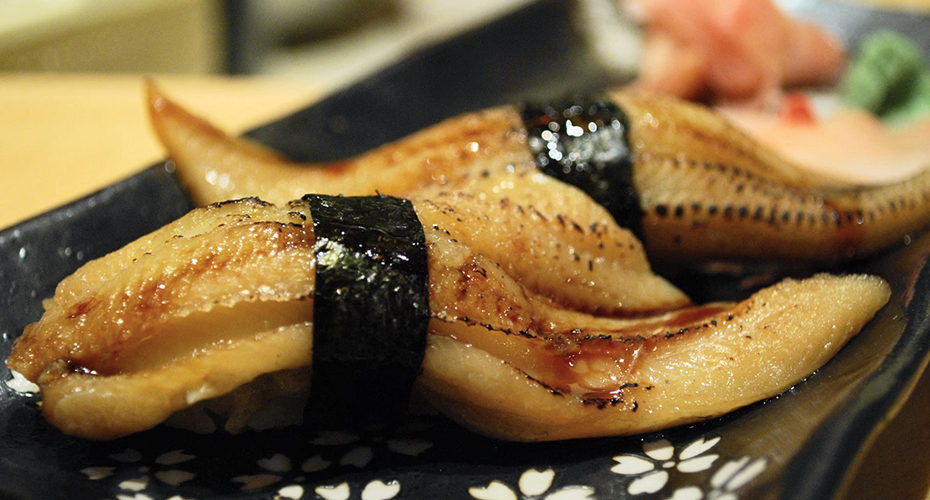Anago sushi might live in the shadow of unagi, but it’s a fish to know. It has many of the same great attributes of freshwater eel, but without the sustainability red flags.
This post covers all things anago. Learn about the species, popular dishes, how anago is prepared, and beverages to pair with it.
What is Anago?
Cooked saltwater eel is called Anago in Japan. It’s extremely popular in Japanese cuisine. Sushi, tempura, and kabayaki are common anago dishes.
The flavor of anago (アナゴ, 穴子) is sweet but delicate. It has a milder profile than unagi. And it’s also a little less common.
Anago is said to be best from late spring to late summer. It’s at its fattiest in June and July.
This anago sushi post is part of an informative sushi and sashimi guide. Check it out if you want to take your sushi game pro.
Whitespotted Eel
Anago is also known as the whitespotted conger eel (Conger myriaster). This fish lives throughout the Northwest Pacific ocean. Whitespotted congers can grow to three feet in length, but the ones used in Japanese cuisine are usually half that size.
Anago Sauce – Tsume
Anago, like unagi, must be cooked before eating. With anago, the fish is simmered or boiled first. The broth is reduced down with soy sauce, sake, and sugar after removing the eel.
Anago sauce is thick, sweet, and savory. The sauce is brushed on just before serving.
Popular Dishes with Anago
Anago sushi is the most familiar preparation for Westerners. But in Japan, kabayaki and tempura are also quite popular.
Anago Sushi
There are two primary types of anago sushi: nigiri and maki.
Anago Nigiri
Anago nigiri is a classic Japanese dish. It consists of a slice of cooked eel fillet over sushi rice. Tsume is brushed on just before serving.
Anago is usually boiled, then broiled. However, this isn’t always the case. Chef Jiro Ono, in his book Sushi Chef Sukiyabashi Jiro, describes his distaste for broiling anago.
The tenderness of anago and its delicate taste is the reason for this. When it’s broiled, anago can fall apart, and the flavor becomes more charred and intense. This masks the subtle flavors that he prefers. He only broils anago upon request from long-time regulars, and that’s only with day-old, firmer eels.
Anago Sushi Rolls
You’re much more likely to find unagi in sushi rolls than anago. However, some chefs choose to use it as an unagi substitute in caterpillar and dragon rolls.
The anakyu maki is the most classic anago sushi roll. It consists of saltwater eel and cucumber. Anakyu maki is made in a thin hosomaki style most of the time. In the US, you may also find it made inside out (uramaki) with rice on the outside.
Anago Sashimi
Sashimi anago is much less common than sushi. You’ll usually have to request it. And it’s still going to be boiled and broiled.
The reason anago sashimi isn’t common is that it can easily fall apart. Sashimi anago may not look as good as the chef would like.
Anago Kabayaki and Shirayaki
Kabayaki is a super popular cooking method for eel. Unagi kabayaki is more common. But anago is used too.
Kabayaki consists of a filleted and butterflied fish that’s skewered, marinated, then grilled. There are different regional variations, and you won’t find it easily in North America.
Shirayaki is similar to kabayaki. But instead of basting eel with a rich and sweet marinade, the fish is seasoned only with salt.
Anago Tempura
Tempura anago can often be found in restaurants that serve anago sushi and in izakaya. The sweet and savory flavor of the eel becomes pronounced. And this method is a little easier to execute than anago nigiri.
Anago Don
Anago don is simply broiled anago over rice. Soy sauce and wasabi are common additions.
How to Prepare Anago
Preparing anago is challenging. But it can be done at home with practice.
Check out this excellent how-to video from Kirikosushi.
Recommended Beverage Pairings
Anago is fantastic with most sake. I like to match the mild and sweet flavor with savory and fresh sake. A hint of sweetness isn’t a bad thing either. For me, that means I’m usually drinking junmai and honjozo grades. And the kimoto and yamahai substyles are often a very good match.
Fruity sake will work too. Delicate, fruity sake contrasts nicely with anago. Semi-fruity junmai ginjo and ginjo grades are recommended.
Check out my Sake Grades and Styles post if you want to learn more about the different types of sake. And afterward, take a look at my Top Sake page if you want to find some classic examples of the different types of sake.
31 Days of Sushi
If you find this post useful or enjoyable, I suggest you check out some of the other content in my 31 Days of Sushi campaign.
Every day in August I’ll share a new piece of content. Topics are centered around nigiri and maki sushi. I include sashimi info, as well.
It’s like an omakase of sushi information!
What Do You Think About Anago?
Do you like anago or unagi better?
Also, do you have a favorite restaurant that serves anago sushi?
Please share your thoughts by commenting below!
